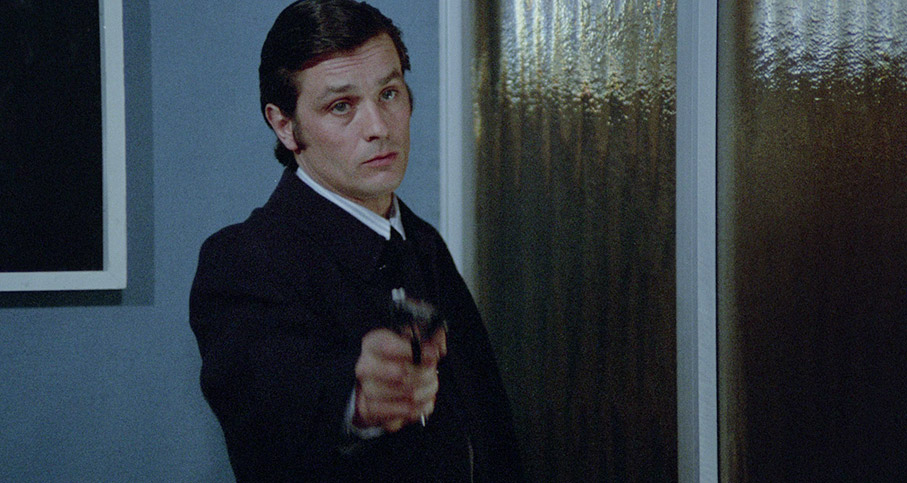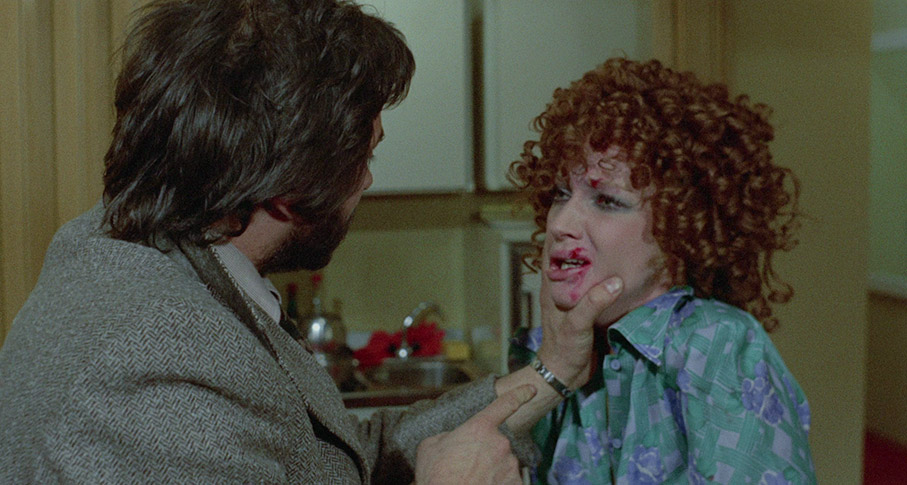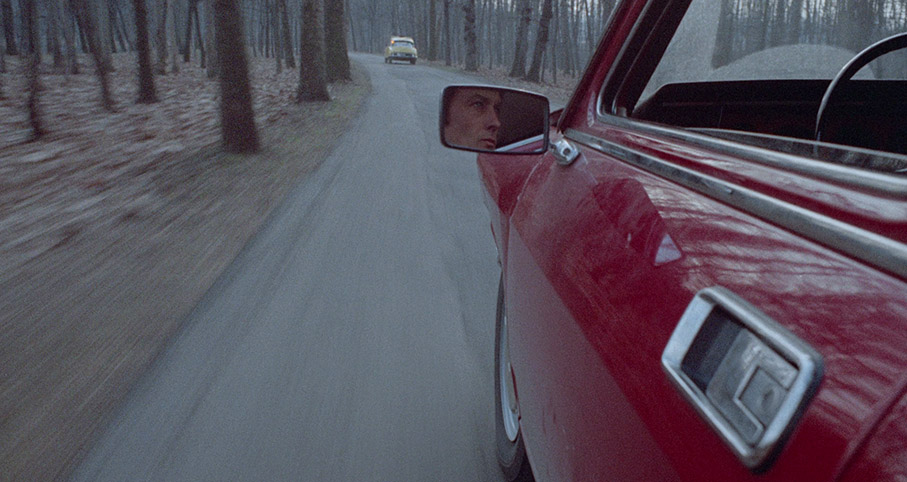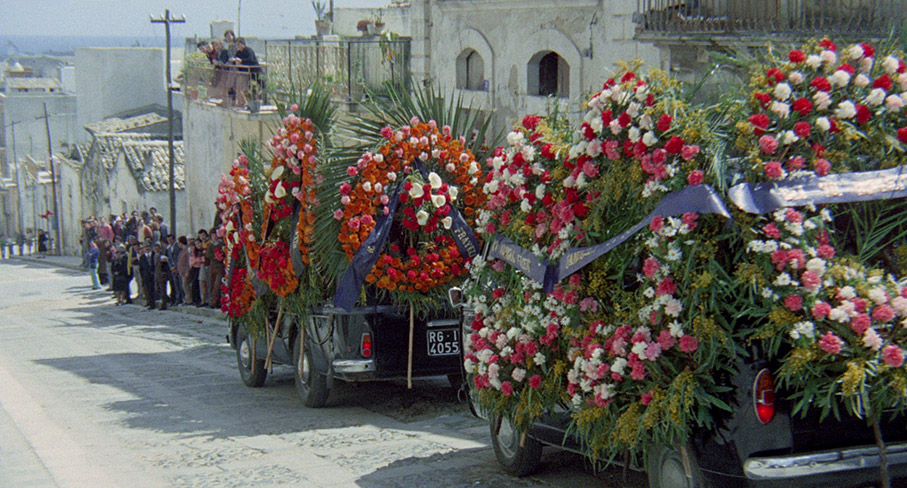Note: Early in this review, I reveal a crucial plot twist that occurs 20 minutes into the film, one that the synopsis on the cover of the Radiance disc has cannily sidestepped. Given that this twist drives the story from that point on, and is difficult to even allude to without making it easy for anyone with a few crime dramas under their belt to guess, I've elected to be upfront about it, but have restricted all mention of it to the second and third paragraph of this review. Thus, if you want to go into the film cold, skip to past the next three paragraphs or click here to do so automatically.
I'm aware that I have a habit of describing in unnecessary detail how the early stages of the plots of the films that I review play out, but just occasionally the overall thrust of the narrative is so straightforward that to do so would be effectively redundant. Such is the case with the 1973 Italian crime drama Tony Arzenta, aka Tony Arzenta (Big Guns), aka No Way Out. Try this for size.
After completing his latest assignment, mob hitman Tony Arzenta (Alain Delon) announces his intention to retire to his boss Nick Gusto (Richard Conte), due to concern about how his profession might later impact the life of his young son Carlo. The news does not go down well with Gusto's fellow mob bosses, who respond by arranging for Tony to be to be killed via an ignition bomb fitted to his car. When a chance event results in the bomb killing Carlo and Tony's wife Anna (Nicoletta Machiavelli) instead, Tony becomes determined to avenge them by killing all of the men who ordered the hit.

Fine detail aside, that's essentially it, but as so often with genre films of the 60s and 70s, it's that detail that ultimately shapes the film and enables it to stand out from a busy crime movie crowd. That's not to say that it doesn't have its share of visible influences. The casting of Alain Delon as a killer for hire inevitably recalls his defining role as ice-cool hitman Jef Costello in Jean-Pierre Melville's 1967 masterpiece, Le Samouraï, a comparison that does no subsequent film any favours. Similarly, it's hard not to believe that the casting of Richard Conte as mob boss Nick Gusto was not influenced by his role as Barzini in Francis Coppola's genre-defining The Godfather (1971), a film in which Corrado Gaipa – who here play's Tony's father – also had a key supporting role. A further shadow is cast by Coppola's film in the shape of the car bomb death of Michael Corleone's Sicilian wife Apollonia, which makes it easy to predict the similar fate that befalls Anna and Carlo.
In the hands of Death Occurred Last Night and The Bloodstained Butterfly director Duccio Tessari, however, such influences are put to consistently impressive use. A prime example comes following a second abortive attempt to assassinate Tony, this time in a drive-by-shooting. Tony and his trusted friend Domenico (Marc Porel) immediately jump into their car and chase the fleeing gunmen in a superbly shot and edited car chase through city streets and country roads, one that takes inspiration from the justly celebrated car chase William Friedkin's 1971 The French Connection, notably in the creative use of shots that accentuate the pace and danger of the pursuit and in the alarming realism of a head-on crash. It could be argued that Tessari then pushes his luck a little by repeating the same trick later, with a third failed attempt to take Tony down resulting in another breathless car chase and another convincingly realistic crash. That this doesn't feel in any way repetitive is down to how well both scenes are handled, from the documentary urgency of the attacks to the planning and execution (no pun intended) of the subsequent chases. Other elements that have been rendered familiar by the passing of time include the ever-dependable friend who later falls foul of Tony's enemies, the seemingly trustworthy individual whose loyalty can be bought for the right price, and gangsters who do not experience even a pang of conscience as they dish out even the most brutal violence.
Ah yes, about that. Canny viewers may have noticed that the BBFC has passed this Blu-ray with an 18 certificate, and when you consider that this film is now half-a-century old and how hard it is to land that certification nowadays, you really can take it as a content warning. If you're familiar with Eurocrime films of the period, you'll be aware that women sometimes get a seriously raw deal, but even with that in mind, two are dealt a discomfortingly bum hand here. Check out a quote from the BBFC certification of the film's original UK release:
A woman is brutally beaten and held hostage by a gang of men. There is an earlier scene in which a woman is also beaten by a man after an implied sexual encounter. A woman is pushed into a boiling hot bath, verbally abused and slapped by her lover.

And 'brutally beaten' is no exaggeration for a scene that had me wincing and shifting in my seat throughout, a reaction I also had to the above-cited earlier beating, which for me was made worse by the fact that Tony just stands there and watches it happen. For many, these scenes will feel unpleasantly gratuitous, and they may be right, I couldn't help but suspect that this was precisely how mob goons of the era would have behaved in the situations in question, though that still doesn't make the scenes easy to watch. And then there's this from the BBFC website:
During a sex show inside a club, two naked women rub against each other and fondle and kiss each other's breasts as men watch.
While few should be surprised by the level of violence and bloodletting in the film given its year of production, the explicitness of this nightclub lesbian sex show did catch me out. Again, the question of whether this is gratuitous or a true reflection of what went on in such (male) gangster run establishments of the day is a question I'm not really qualified to answer.
If all of this makes Tony Arzenta sound like a jumble of exploitation genre tropes and opportunistic borrowings, I'm doing it a serious and unintented disservice. The blame for the fact that the thrust of main story holds few real surprises can be laid at least partially at the feet of the passing of time and the subsequent recycling by later filmmakers of elements that doubtless felt fresh back in 1973. What stands the film apart from its contemporaries – and even a good few films that followed – is its unusually rich degree of character and story texturing, an aspect particularly evident in the humanisation of a central character that continues to this day to be portrayed as an emotionally detached and isolated loner. Having a mob assassin attend his young son's birthday party and say a fond goodbye to his wife before heading off to carry out a contract killing, then come home afterwards and gently kiss his sleeping son still feels like a new take on an otherwise familiar genre figure. He even pays regular visits to his father and mother (Carla Calò) at their countryside home, and has a warm relationship with their local priest, Don Mariano (Guido Alberti), who keeps a protectively watchful eye over the couple when their son is out of town.
The cast is certainly a key selling point here. There's almost a sense that Alain Delon is drawing on his role in Le Samouraï to explore how things might have played out for Jef Costello in an alternative timeline, one in which he had a wife and child and because of them decided to quit a business that has only one retirement option. Although as skilled and cool an executioner as Costello, Tony is clearly not as emotionally cold, a trait revealed during the opening kill in the almost comical "sorry, but…" shrug he gives an unfortunate witness before dispatching him too. Channelling his memorable work in The Godfather, Richard Conte makes for a convincingly authoritative mafia boss, and the supporting cast of fellow mob leaders and foot soldiers is peppered with solid performers and interesting faces, including an curiously uncredited Anton Diffring as German criminal empire-builder Hans Grünwald.* Probably the toughest job here falls to Carla Gravina as Sandra, the woman who becomes the target of the lion's share of the violent abuse outlined in the BBFC certification. Later, she becomes a figure of hope and redemption for Tony, and her sly signalling to him of the location of one of his would-be assassins when he returns to his apartment prefigures a similar moment in the later L.A. Confidential. The extra dimension that even the bit-part players bring to characters that in the wrong hands could have been mere background fodder is matched by the energy and life that director Tessari brings to the storytelling, with static shots and smooth camera movements giving way to verité-style handheld footage when the action hots up, and some eye-catching bolted-to-the-vehicle angles during the two showpiece car chase scenes.

I'll admit that the sheer number of characters we meet in the early scenes, often without specific reference to who they specifically are, saw me almost lose track of where I was a couple of times, but revisiting the film made me realise that this was primarily down to me not paying close enough attention to seemingly throwaway moments of dialogue. Yes, there are borrowings from other genre movies and (then) recent Hollywood hits, but that's always been par for the Eurocrime subgenre, and director Tessari gives these elements his own distinctive spin and puts them to often arresting use. Intermittently, there's an almost expressionistic use of dark and light, with Tony's melancholia reflected in the gloom of some of the interior scenes, which give way to brighter exteriors when Tony energised and giving chase, or at peace while conversing with his father on his parents' garden patio. Yes, some story beats do play to convention, and there can be few fans of crime movies who will fail to predict how this one will conclude, although the specifics still deliver an effective surprise and a memorable final freeze-frame. Overall, it's a thoughtful, involving and moody character study punctuated by moments of discomforting violence and a couple of thrillingly staged action scenes. An engaging cast, the sly
presentation of mafiosi gang leaders as corporate businessmen, and an unexpectedly strong focus on family and friendships lift it well above the genre average, and while those two car chases and the assassination attempts that trigger them would justify the ticket price alone, Tony Arzenta has so much more to offer.
The version of the film included on this Radiance Blu-ray is, as far as I'm aware, uncut and the result of a new restoration, and while I don't have the exact details of precisely what former cuts might have been restored, the shots in question are easy to spot. How? Well, if you elect to watch the English language version, there are two occasions where the dialogue switches briefly from English subtitled Italian. The inference of this is that these scenes were at some point cut from this version and the English soundtrack for them has since been lost, though if this was the case I have to presume the edits were made either before the film was submitted to the BBFC or at a later date. The latter seems more likely, as no cuts are detailed on the BBFC website, and the first of the subtitled scenes is the violent beating included in the BBFC content warning, confirming that it was present in some form when the film was certified.
The second subtitled scene is an assassination that I'll avoid detailing further here, and while the shooting itself is no more violent than any of the killings that precede it, in this case the fatal bullet passes through its victim and smashes an aquarium. This leaves the fish originally contained within flapping about in the resulting wreckage, a shot that may well have fallen foul of British censorship laws on animal cruelty. I'm not sure why this would have required the preceding dialogue to be cut unless the entire sequence was chopped and doing that would have left the film with an unresolved plot hole. It's possible that this is all answered in the booklet that accompanies this release, but at present I do not have a copy for review.
Another fine 1080p transfer from Radiance, albeit one that occasionally feels a little dark with resultingly weak shadow detail, a grading decision that the perfectly pitched daylight exterior scenes elsewhere tend to suggest was a deliberate and mood-setting choice on the part of director Tessari and cinematographer Silvano Ippoliti. The image is at its most vibrant in the final scenes in what feels like an expressionistic symbol of hope, a trick that few crime movie fans will be remotely fooled by. The muted colour palette in the darker scenes also feels like a deliberate choice, one reflected in – and reflective of – the drab greys and blacks of the clothing worn by the film's male characters. When brighter colours do make an appearance – the first victim's yellow bathrobe, the bright green push-button radio in Tony's apartment – they are vividly rendered. Detail is very well defined throughout, and a fine film grain is visible.

Both the Italian and English soundtracks have been included here, and as many of you will doubtless be aware, Italian genre films of the period were usually shot silent and the dialogue added in post-production. Many of these films featured actors from other European countries and beyond, and this allowed them to deliver their lines in the language with which they were most comfortable rather than being required to learn all their lines in Italian. As a result, both the English and Italian tracks are post-dubbed, and both have their positive and negative aspects. Although the Italian track may seem the obvious default given the film's country of origin, French actor Alain Delon is the star and it's clear from the perfect match of dialogue and mouth movements that he delivered all of his lines in English, and I gather he also dubbed his own voice on that track. Add to this the fact that Richard Conte and a handful of others are also clearly speaking English and it would seem like a slam-duck for the English track. Well, not quite. Sonically, this track is considerably flatter than the Italian equivalent and lacks its far brighter treble response. This is especially evident with Gianni Ferrio's music score, although this does mean that it never hits the high-pitched, eardrum-piercing notes that occasionally had me reaching for my earplugs when listening to the Italian track. Where the English track does occasionally trip up is on a small number of sound effects – an angry slap, the closing of a car door – that are out of sync with the picture, effects that are perfectly synchronised on the Italian track. I still just prefer the English track, but it's great to have the choice.
Optional English translation subtitles are provided for the Italian soundtrack, and optional English subtitles for the hearing impaired are available for the English language track. A third subtitle track invisibly kicks in if you elect to watch the film with the English language soundtrack and no subtitle assistance and provides English translations for the two restored sequences discussed above where the dialogue switches briefly to Italian.
Alain Delon (12:08)
An archival interview with actor Alain Delon that was first broadcast in September 1973 when two Delon films were making the news, José Giovanni's Two Men in Town and Tony Arzenta, the latter of which here is referred to as Big Guns. Unfortunately, that's the only mention it gets, the prime focus initially being Two Men in Town, on which Delon also acted as producer. Delon also talks about three self-defined periods of career, ones in which he worked for directors Lucio Visconti, René Clément and Jean-Pierre Melville. Sizeable extracts from Two Men in Town and Le Samouraï are included.
Mike Malloy (11:13)
A video essay by filmmaker Mike Malloy that examines the themes and trends that define the Eurocrime subgenre of the 1970s and Tony Arzenta's place within it. The popularity of the One Last Job trope and the domination of cop and gangster films is discussed, as are the exceptions built around lone figures such as safecrackers and contract killers. Malloy also uses Tony Arzenta as an example of casting cohesion by citing other genre works in which many of its actors appeared. I found this fascinating.

Scene Specific Audio Commentary by Peter Jilmstad (53:29)
In a scene-specific commentary that covers about half of the film's running time, Peter Jilmstad – the co-host of the Fragments of Fear giallo podcast – elects to focus on the film's rich supporting cast. He may not be the liveliest of speakers, but the sheer level of detail he provides on each of the actors had me glued nonetheless, and I really appreciated the info on the film's production history and the mistranslation that resulted in the Big Guns alternative title. He's clearly a big fan, praising the work of director Duccio Tessari and describing the film as a whole as "a perfect package." The option is offered to either watch each of the six discussed scenes individually, or to play them all.
Trailer (3:50)
An Italian trailer, under the title of Tony Arzenta Big Guns, that presents the film as a violent, all-action thriller with brief pauses for characters to chat. That said, it would certainly have me wanting to check the film out, despite a sprinkling of inevitable spoilers.
The commercial release also includes a Limited Edition Booklet featuring new writing by scholar Leila Wimmer, but this was not supplied with the review disc.
An unsung Eurocrime classic it may not quite be (feel free to differ on this point), but Tony Arzenta is still a compellingly handled crime drama with a melancholic air, well-defined characters, a damned fine cast, and a couple of superbly handled action scenes. As I stated above, I strongly suspect that the visual gloominess of some scenes was a deliberate choice, and the transfer on the Radiance disc is otherwise first rate, and the special features all very well targeted. Warmly recommended.
|